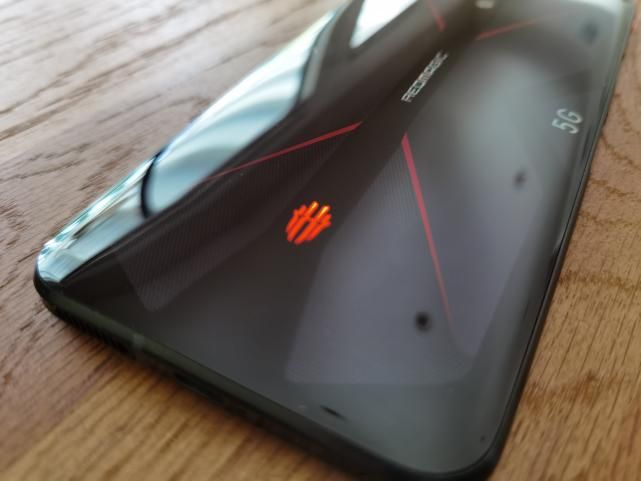Not too long ago, playing games on smartphones was just a casual affair. Games like Angry Birds or Candy Crush, which were simple games that required basic input, were dominating the market. If you wanted to play games with more complex mechanics and gameplay, you either get yourself a decent desktop or a console.
Now, though, the landscape is much different. While casual games are still very much a thing, smartphones can actually run heavier games as well, such as The Elder Scrolls: Blades, PUBG, and Fortnite. We also have phones that are actually geared specifically for gaming. The Razer Phone in late 2017 kickstarted the subgenre of “gaming” smartphones: phones made from the ground up with gaming in mind.
Nubia also makes some pretty compelling offerings with its Red Magic sub-brand. The Red Magic 5G from this year is the latest one, and it comes with the highest refresh rate ever on a smartphone display at 144Hz. It is just one of the many new gaming-oriented features this phone includes. It also obviously comes with a Snapdragon 865 for its guts as well as other features, but do they actually make a difference compared to other 2020 flagships? We’ve got our hands on the Red Magic 5G and we’ve done a rundown on how good it actually is, with a big focus on the gaming department.
| Specification |
Nubia Red Magic 5G |
| Dimensions and Weight |
- 168.56 x 78 x 9.75 mm
- 218g
|
| Display |
- 6.65″ FHD+ AMOLED;
- 19.5:9 aspect ratio
- 144Hz high refresh rate
- 240Hz touch sampling rate
- In-display fingerprint sensor
|
| SoC |
Qualcomm Snapdragon 865
Adreno 650
|
| RAM and Storage |
- 8GB LPDDR5 + 128GB UFS 3.0
- 12GB + 128GB
- 12GB + 256GB
- 16GB + 256GB
|
| Battery & Charging |
- 4,500 mAh battery
- 55W fast charging
- Compatible with Quick Charge 4.0 and Power Delivery 3.0
|
| Rear Camera |
- Primary: 64MP Sony IMX686 sensor, f/1.8
- Secondary: 8MP, Wide-Angle Camera
- Tertiary: 2MP, Macro
|
| Front Camera |
8MP |
| Other Features |
- Active cooling through a rotating fan within the phone
- 3.5mm headphone jack
- Low latency game screencasting
- Touch-sensitive shoulder buttons
- WiFi 6
- Dual-frequency GPS
- Side pins for further docking
|
| Android Version |
Red Magic OS based on Android 10 |
About this review: Nubia loaned us a Red Magic 5G unit for review purposes. All opinions in this article are completely our own. Nubia did not have access to this review before its publishing.
Red Magic 5G Forums
Red Magic 5G: Design
Glass-sandwich smartphones have become the defining trend in the past few years. Though lately, some phones have tried to differentiate themselves with some extra details coming in the form of gradients or refracting effects. Don’t get me wrong, they’re still cool and all, and every once in a while we get new, awesome-looking effects, such as Aura Glow on the Galaxy Note 10 and Interstellar Glow on the OnePlus 8. The Red Magic 5G does things differently here, for better or for worse.

The Red Magic 5G sports a pragmatic, unique style compared to other smartphones. The back is still glass, but instead of a bland gradient, there is a more intricate design that screams out loud the true nature of this phone: this device is focused on gaming, inside and out. There is still sort of a gradient effect on the black variant, but the main design features we mentioned previously are still the most prominent and noticeable. We have very noticeable Red Magic branding below the triple rear camera setup, which features an IMX686 sensor. Other gaming phones have often gone overboard with their “gaming” branding — and the Red Magic 5G appears to take the middle road.



Upfront, the display doesn’t have any kind of notch or hole-punch camera. Instead, the display features two small bezels on the top and bottom, more similar in fashion to 18:9 phones even though the display is 19.5:9. On a phone like this, it makes sense: any disturbance to the display can disrupt the phone’s gaming experience. The small bezels also help with grip while playing horizontally, so we aren’t complaining.
On the sides of the device, in a similar fashion as other phones: we have the usual power button and volume rockers, but we also have pressure-sensitive shoulder trigger buttons. We’ll talk about these in detail later on, but suffice to say, they do make a difference while playing. There is also a dedicated button for toggling Gaming Mode, needed to kick the fan into power.
Red Magic 5G: Performance
For the performance review, we’re going to open up with 2 sections. First up, we’ve got a “benchmarks” section which will allow us to measure the Red Magic 5G’s might in raw numbers, allowing us to more easily compare how it stacks up against other smartphones. But of course, benchmarks are just a raw indicator and do not necessarily give us an exact picture of how well this phone performs, so an actual gaming performance test will follow.
Benchmarks
We’re testing out three different benchmarking apps for this review: Geekbench 5, PCMark Work 2.0, and 3DMark. We’re comparing the Red Magic 5G against the OnePlus 8 Pro (another Snapdragon 865 smartphone), the Huawei P40 Pro (powered by the Kirin 990 SoC), the Samsung Galaxy S20+ (powered by the Exynos 990), and the older OnePlus 7T based on the Snapdragon 855+ processor. This will allow us to roughly measure how the device stacks up against other high-end smartphones.
The Red Magic 5G has an edge against all the other smartphones in this list, and that is the display’s refresh rate: 144Hz. The OnePlus 8 Pro and the Galaxy S20+ have 120Hz displays, while the P40 Pro and the OnePlus 7T have 90Hz ones. So it will be interesting to see how much of an impact the higher refresh rate display has on overall performance in this situation.
Geekbench 5 (Free, Google Play) →

Geekbench 5 gives us a single-core score of 908 and a multi-core score of 3041. By contrast, the OnePlus 8 Pro, the closest device in this list, performs roughly the same in single-core (897), and does slightly better in the multi-core regard (3339). This could be attributed to things like poorer software optimization on the Nubia, the fact that 144Hz demands a higher CPU load, etc. It does better than other phones in the list though, including the Exynos 990-based Galaxy S20+ and the Kirin 990-based Huawei P40 Pro as well as, evidently, the OnePlus 7T.
PCMark for Android Benchmark (Free, Google Play) →

PCMark gives us a slightly different panorama though, as the phone scores 12891 in the Work 2.0 overall test. The Galaxy S20+ comes in second here at 11962 while all other smartphones in the list perform slightly less than that. Oddly, though, the device manages to score quite a bit more than the OnePlus 8 Pro, which comes with the same system-on-chip.
3DMark - The Gamer's Benchmark (Free, Google Play) →

Lastly, 3DMark Sling Shot tests throw a 7305 figure for the Red Magic 5G, similar to the score in the OnePlus 8 Pro and way ahead of other smartphones such as the P40 Pro, which scores 6058.
Gaming Performance
As for the actual gaming performance section, we tried out 6 different games for this review, all of which are available on the Google Play Store:
- Real Racing 3
- PUBG Mobile
- Bullet Force
- Gear.Club
- Dead Trigger 2
- Vainglory
These are some of the most popular games on the Google Play Store as of right now, which is why we picked them out. The Red Magic 5G has a 1080p resolution, and 1080p games are not that difficult to render by themselves compared to games in 1440p. However, we have a 144Hz display here, which is a first for a phone, so it will be interesting to see how well games run here. And to our surprise, the phone doesn’t disappoint one bit.
Thanks to GameBench for providing us a journalist license. GameBench is a suite of tools for developers to analyze the fluidity, power consumption, and memory usage of games. GameBench is available as an app on Google Play and as a desktop application. For more information, visit GameBench.net.
Real Racing 3
Real Racing 3 (To be announced, Google Play) →
Published by Electronic Arts, Real Racing 3 is one of the most popular racing games for Android phones, clocking in at 500 million installs, and as it stands, it is also notably resource-intensive. Yet it is not a problem for the Red Magic 5G which manages to pull off a median of 145 fps, as high as the phone’s display allows, with a stability of 95%, meaning that the game runs smooth as butter most of the time with very rare small frame drops here and there.

PUBG Mobile
PUBG MOBILE - Mad Miramar (Free+, Google Play) →
PUBG Mobile is a game most of you are probably acquainted with: it originally launched on PC and helped popularize the battle royale genre together with Fortnite. It also made its way to Android phones as well. Performance-wise, however, the game runs as good as it can run: it is capped at 60 fps, so it won’t run over that even if the phone allows for it. With a perfect 100% stability, though, frame drops are completely non-existing in this realm.

Bullet Force
Bullet Force (Free+, Google Play) →
Bullet Force is another popular shooter game available on the Google Play Store, clocking in at 10 million installs. While not as popular as other shooters, this one does have an advantage over the others, and it’s the fact that the game can run at the full capabilities of the phone’s 144Hz display. With a median of 145 fps and a stability of 98%, the phone can easily handle the game like no other Android phone can as of now.

Gear.Club
Gear.Club - True Racing (Free+, Google Play) →
Gear.Club is another racing game that is not as popular as alternatives such as Asphalt 9 and Real Racing 3 (which we also tested earlier), but it’s also a game that we wanted to test out for being a tad bit more intensive than Real Racing 3. Despite this, it is still no big task for the Red Magic 5G. This game is, again, capped at 60fps, so we get similar numbers to the ones we saw in PUBG: median 60 fps, 93% stability, which means that frame drops do exist here, but they’re very rare. It would be curious to see how the game runs at the phone’s max framerate.

Dead Trigger 2
DEAD TRIGGER 2 - Zombie Game FPS shooter (Free+, Google Play) →
Dead Trigger 2 is a survival horror game for Android devices and a pretty popular one at that: it has over 110 million installs. It is no match, however, for the Red Magic 5G. The game takes full advantage of the 144Hz display, and again achieves a median of 145 fps and almost-perfect stability of 98%.

Vainglory
Vainglory (Free+, Google Play) →
Lastly, we have Vainglory, which is another popular game that takes advantage of the device’s unparalleled high refresh rate. We get an average of 145 fps with 95% of stability, meaning that it’s running most of the time at full steam.

Red Magic 5G: Camera
On the camera front, the device is far from being the most capable out there, but it still doesn’t disappoint if you need to snap something quickly. Even if you buy this phone specifically for gaming, you’ll want a decent camera. The phone has a 64MP IMX686 sensor as the primary sensor, and it is coupled with a secondary ultra-wide 8MP lens as well as a macro 2MP lens for all your macro shot needs.
Unfortunately, we weren’t able to do as much camera testing as we would’ve wanted to, given how the ongoing COVID-19 pandemic is forcing us all to stay home. But from our limited testing, we’ve found that the Red Magic 5G, while not close to being a camera champion (albeit still pretty decent for its price point), is able to provide an average camera experience given good lighting conditions. It won’t disappoint you too badly, but it won’t blow you off your seat either.






Nubia Red Magic 5G camera samples.
Colors seem as accurate as they go and you may come across some oversaturation in certain shots, but nothing that’s a dealbreaker here. The whole point of the phone isn’t really its camera, after all, but the gaming experience at the forefront.
Selfie needs are served by a single 8MP sensor, which is, again, an average choice that won’t stand out or disappoint. It also has an AI-based portrait mode which is based on face detection and blurs the background behind you.

Red Magic 5G: Battery Life & Charging
The Nubia Red Magic 5G features a 4,500 mAh battery. A battery of this capacity has been able to provide excellent battery life in several smartphones. However, in this case, the Red Magic 5G features a 144Hz display as well as other features such as the dedicated fan which can, and will, sip a bit of battery compared to other conventional smartphones. The OnePlus 8 Pro, for instance, features a very similar battery capacity, at 4,510 mAh to be precise, and it has been proven that using the phone in 120Hz mode has taken a toll in battery life. Our results in this regard have been kind of a mixed bag as well, as 5G connectivity can also sip battery.
If battery life is insufficient though, the phone supports ultra-fast charging: it supports blazing-fast 55W charging (the 55W fast charger is sold separately). We weren’t able to test out the fast charger since it’s sold separately, but it should be able to top up the phone’s battery in record-breaking times. Out of the box, the Nubia Red Magic 5G comes with an 18W charger but also supports Qualcomm Quick Charge 4+ (27W) charging if you have a supported charging cable and adapter. In our testing, we found that it takes approximately 1 hour and 26 minutes to charge the Red Magic 5G from 0 to 100% using the included 18W charger.

To test the real-world battery life, we used PCMark’s Work 2.0 battery life benchmark. PCMark’s Work 2.0 battery benchmark iterates the standard Work 2.0 benchmark (which runs the device through a serious of tasks that simulate real-world activities like web browsing, image editing, or document reading). Unfortunately, we kept getting an error that didn’t let the benchmark run to completion (ie. from 100% down to 0%). When the test did end by itself, however, our device’s battery life was left at 18% after 8 hours and 38 minutes of the test running. This was at a brightness level that was at about half of the maximum, so we can expect the Red Magic 5G to last a decent while in day-to-day use.
But what about the battery life while gaming? To test that, we used GFXBench’s Manhattan battery life benchmark, which runs the device through multiple iterations of the Manhattan 3.1 OpenGLES 3.1 test, a graphically intensive benchmark. When the test ended, GFXBench estimates our Red Magic 5G will last 177.4 minutes of continuous playtime. Of course, Manhattan 3.1 isn’t a real game, so this number is just an estimate of how long the device should last while continuously playing a super graphically intensive game.


Furthermore, the detailed GFXBench results show that the Red Magic 5G barely throttled. In fact, the Manhattan 3.1 scores throughout the 30 iterations of the test only fluctuated from 4498-4523. We can see that the battery temperature increased from ~33°C to about ~49°C. Lastly, we should note that GFXBench automatically sets the brightness to maximum (100%), so that 177 minutes of playtime means you should get nearly 3 hours of gameplay at the phone’s maximum brightness. Max brightness is a bit much for many users, though, so you can expect to get even longer playtimes just by decreasing the brightness.

Detailed performance and battery temperature over time results from GFXBench’s Manhattan 3.1 battery benchmark.
(We also ran the GFXBench Manhattan 3.1 OpenGLES battery benchmark test with gaming mode on. While the final battery life result didn’t improve much—GFXBench thinks the phone will last 179.7 minutes, a 2.3 minute improvement—the performance fluctuated a bit less and the maximum battery temperature it reached was a bit lower, topping out at ~45°C with the fan running instead of ~49°C without. Using a temperature reader, we also measured the final surface temperature of the device after GFXBench completed and found the temperature to be near ~46°C.)
GFXBench Benchmark (Free, Google Play) →
5G connectivity
Of course, the phone has a Snapdragon 865 processor, and as such, one of the headlining features we’re seeing here is support for 5G connectivity. This 5G connectivity is, however, not really useful for users in the US. It doesn’t provide extensive coverage for most network bands used in the US, and 5G ones are mostly out of question as well. Your mileage may vary on Asian/European markets, where you might do a little better.
Extras
Amongst the phone’s most exciting features aimed at gamers, you’ll be able to find “shoulder triggers,” which are touch-sensitive buttons you can find on the sides of the phone that take your gaming experience to another level. These shoulder triggers allow for easier access to the furthest edges of your screen without making you go through the awkward reach that tends to happen when playing on phones with a screen as big as the one in the Red Magic 5G.


The Red Magic 5G’s shoulder triggers in closer detail.
Whilst in the phone’s Game Space 2.1, you’ll be able to customize the way these buttons work for every game you play. For example, while playing Call of Duty: Mobile, you can make them act like the L2 and R2 buttons of the PlayStation 4’s DualShock 4 controller to point and shoot. This is easily a feature that’ll make your gaming experience better as these shoulder triggers replace the on-screen buttons on certain games allowing for a smoother experience.
Another one of the features you can find on the Nubia Red Magic 5G is the third generation of Nubia’s Turbo Fan technology which integrates an internal fan and an advanced liquid cooling system that tries to maintain the phone on an adequate temperature most of the time. Within the Game Space 2.1, you could decide to turn the fan on or off, albeit it’s off by default.

The Red Magic 5G’s internal fan sits to the left of the phone.
The results we’ve found while checking out this feature are… lukewarm, for lack of a better word. When the phone is running hot, enabling it doesn’t really help make the phone any cooler. Turning it on before putting strain on the phone, however, helps to slow down the increase in temperature. The phone’s thermal performance, as well as the effectiveness of the Turbo Fan, can be affected by several factors, such as the environment and the ambient temperature. While, in function, it’s little more than a gimmick, it may help out for extended gameplay periods to avoid the phone from getting hot quickly.
Conclusion
The Red Magic 5G is a phone that, at its core, is meant to serve a narrow market: hardcore gamers that want to squeeze the maximum performance possible out of a device. This is not your average flagship phone: while some features included in this device could very well make their way to other consumer smartphones and serve a purpose, such as the 144Hz display, it may not sit as well with more casual customers: the cameras are average at most, not everyone could like the phone’s design, and the display has visible bezels. Plus, most of these gaming features could also be just gimmicks to sp,e users. If you care about any of these things, then you should probably look away from this phone.
If, however, your priority is performance and using the most out of your device, then this is a splendid smartphone. It’s got a Snapdragon 865, so you get the best performance in the market right now. It has up to 16 GB of RAM and 256 GB of storage, so it will be able to handle everything you throw at it, and it has plenty of features that can greatly enhance your gaming experience. After all, this phone’s entire existence revolves around gaming. The shoulder triggers are greatly useful for several games where a touch interface may not sit as well, such as Fortnite and Call of Duty: Mobile. The integrated fan is better on a spec sheet than in real life, but if you use it correctly, it can help keep high temperatures at bay for longer.
Red Magic 5G Forums
Buy the Red Magic 5G from RedMagic.gg
If you’re a hardcore gamer looking for a phone that can keep up with you, then this is probably worth checking out.
Written with many inputs from Arol Wright and Mishaal Rahman.
The post Red Magic 5G Gaming Review: Smartphone Gaming has Never Looked Smoother appeared first on xda-developers.
from xda-developers https://ift.tt/2Xal4ss
via
IFTTT






























